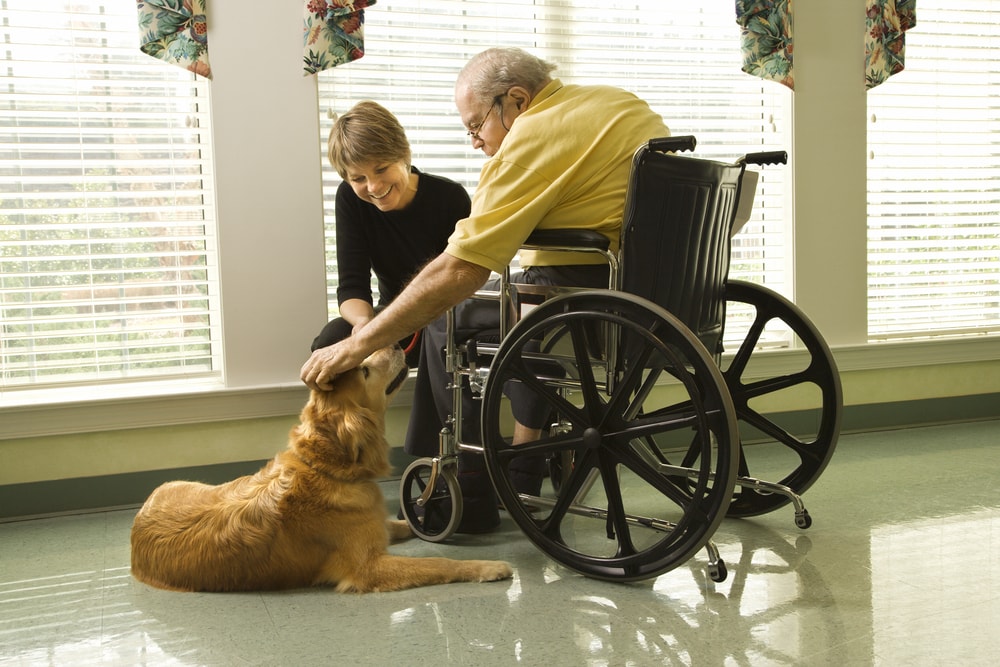
Psychiatric Service Dogs (PSDs) are specially trained dogs that help to assist their handlers with at least one task. PSDs are extremely invaluable dogs that assist people with mental illnesses in numerous ways. Some of the things they can be trained to do include coping with anxiety attacks, providing medical assistance or medication reminders, and waking people up from night terrors.


The 7 Tips For Training A Psychiatric Service Dog
There are a few ways to go about getting a PSD. Adopting a PSD is one of the easiest ways, but they’re often very expensive, and you can end up being placed on a waiting list. Training one on your own can be one of the most cost-efficient ways, but you must be prepared to spend a lot of time and commitment on training.
1. Find the Right Dog
While it’s possible for any dog breed to become a PSD, certain dog breeds tend to be better candidates than others. This is because they tend to have temperaments that are a better fit for PSD tasks. When looking for a PSD candidate, it’s important to look for dogs that are sociable and sensitive to human emotions. They should also have a calm temperament and not be easily distracted.
Typical dog breeds that end up being successful PSDs include Labrador Retrievers, Golden Retrievers, German Shepherds, Lhasa Apsos, and Cavalier King Charles Spaniels. Hybrid dog breeds, like the Australian Labradoodle and Goldendoodle, are also popular PSD candidates because of their intelligence and low-shedding coats.
2. Be Consistent
It’s important to have realistic expectations when training your dog to become a PSD. It’s going to take some time for your dog to learn basic obedience skills, pass a General Public Access Test, and learn specific tasks for mental health needs.
Consistency is going to be crucial with training. Training your dog multiple times a day will help them to remember all the things that it’s been learning more quickly. Make sure also to keep training fun in order to keep your dog interested. Use treats and plenty of praise and rewards to encourage your dog. If you sense that your dog is getting bored at any time, it’s helpful to take a break and reduce the duration of training sessions while increasing the frequency of sessions throughout the day.


3. Train in a Variety of Places
Exposure and socialization are key to the success of PSDs. Dogs often need to be trained to perform the same tasks in different environments and situations in order to learn that the same training rules apply to all situations. Taking dogs to different places, both indoors and outdoors, will help them get used to all kinds of surroundings.
Dogs should also be well-socialized to prevent any incidents related to aggression or anxiety. Like people, dogs will have their own social preferences. Some will enjoy being around other dogs and strangers, while others prefer to be left alone. PSDs don’t have to be extremely social dogs, but they should learn to remain calm and act appropriately if they’re approached by another dog or strangers.
4. Keep a Training Log
Keeping a training log will help you to track the progress of your dog’s PSD training. A training log will include the frequency and duration of training sessions you have each day. It’s also helpful to make quick notes about how well your dog is performing a skill or how quickly they’re learning a new skill. This will help you to make any necessary adjustments to your training. A training log should also record your dog’s rate of success with each task. This is helpful in determining if your dog has adequately learned a skill or still requires some additional training.
5. Train for General Public Access Test
PSDs are protected under the Americans with Disabilities Act (ADA). While there aren’t specific requirements that dogs must meet to be categorized as PSDs, the ADA does state that PSDs must be trained and able to help people complete tasks that they wouldn’t be able to do on their own.
Dogs don’t have to pass specific tests or receive certifications to qualify as a PSD. However, as a general rule of thumb, your dog should be able to pass a General Public Access Test.1 General Public Access Tests are considered to be the bare minimum skills that all service dogs should have. They examine your dog’s ability to follow basic obedience commands and test for additional skills. Some examples include dogs being able to enter and exit a vehicle in a controlled manner, approach and enter buildings with focus and attentiveness to their handlers, and remain heeling throughout a building.


6. Train for Psychiatric Service Dog Tasks
Once your dog has passed a General Public Access Test, they’re ready to move on to learning tasks specifically related to mental health needs. Some things that PSDs can help people with include emotional support, medication reminders, and fetching items. PSDs can also learn to help ground people who start to feel intense emotional distress and provide deep pressure therapy or warmth stimulation.
A PSD only has to be adequately trained in one task. So, start small and work on one task at a time. This will prevent confusion and keep your dog from feeling overwhelmed.
7. Work With a Professional Trainer
While there aren’t a whole lot of specific requirements for PSDs, it’s still helpful to ensure that they’re well-trained and equipped to perform their tasks consistently and reliably. Working with a professional dog trainer can be a great way to get started and build a strong foundation for you and your dog.
A professional dog trainer can help with teaching your dog basic obedience skills and exposing them to different environments and situations in manageable increments. Some dog trainers are also experienced in training and working with service dog candidates and can provide a lot of advice on the training process. It’s much easier to have someone walk you step by step in training your dog, especially if you have little experience in training dogs to perform specific tasks.




Do Psychiatric Service Dogs Require Registrations?
No, the ADA doesn’t require proof or documentation for PSDs. PSDs also don’t need to receive a specific kind of training or certification. However, when it comes to airline travel, the Department of Transportation does allow airline companies to request documentation for service animals before booking a flight for them.
Keep in mind that PSDs must be leashed at all times when in public spaces unless their task requires them to be off-leash. Handlers also must be able to maintain control of their PSDs. Store managers can request dogs to be removed from their premises if they are uncontrollable and their handlers aren’t able to take effective action on settling them down.
Psychiatric Service Dog vs Emotional Support Animals
The main difference between PSDs and emotional support animals (ESAs) is that PSDs are trained to perform specific tasks, while ESAs provide comfort and companionship. PSDs typically require more training because they must accompany their handlers everywhere and perform more complex tasks. While establishments can’t refuse PSDs, they can refuse ESAs from entering their property.
A PSD is also different from a therapy dog. A therapy dog is trained to provide comfort to multiple people in various settings, such as disaster areas, hospitals, schools, and hospices. A PSD can provide emotional support, but they’re trained to help one person rather than multiple people.




Conclusion
Training dogs to become PSDs will take a lot of time and patience, but it’s always worth the effort because of the amazing help and relief they can bring. Start by looking for a dog that has a temperament that best matches the tasks they’ll have to learn to do. It’s often helpful to work with a professional dog trainer to ensure you and your dog get a strong start. As you stick with training, your dog will eventually become a well-trained PSD and have an important job in helping people who really need it.
Featured Image Credit: Africa Studio, Shutterstock


